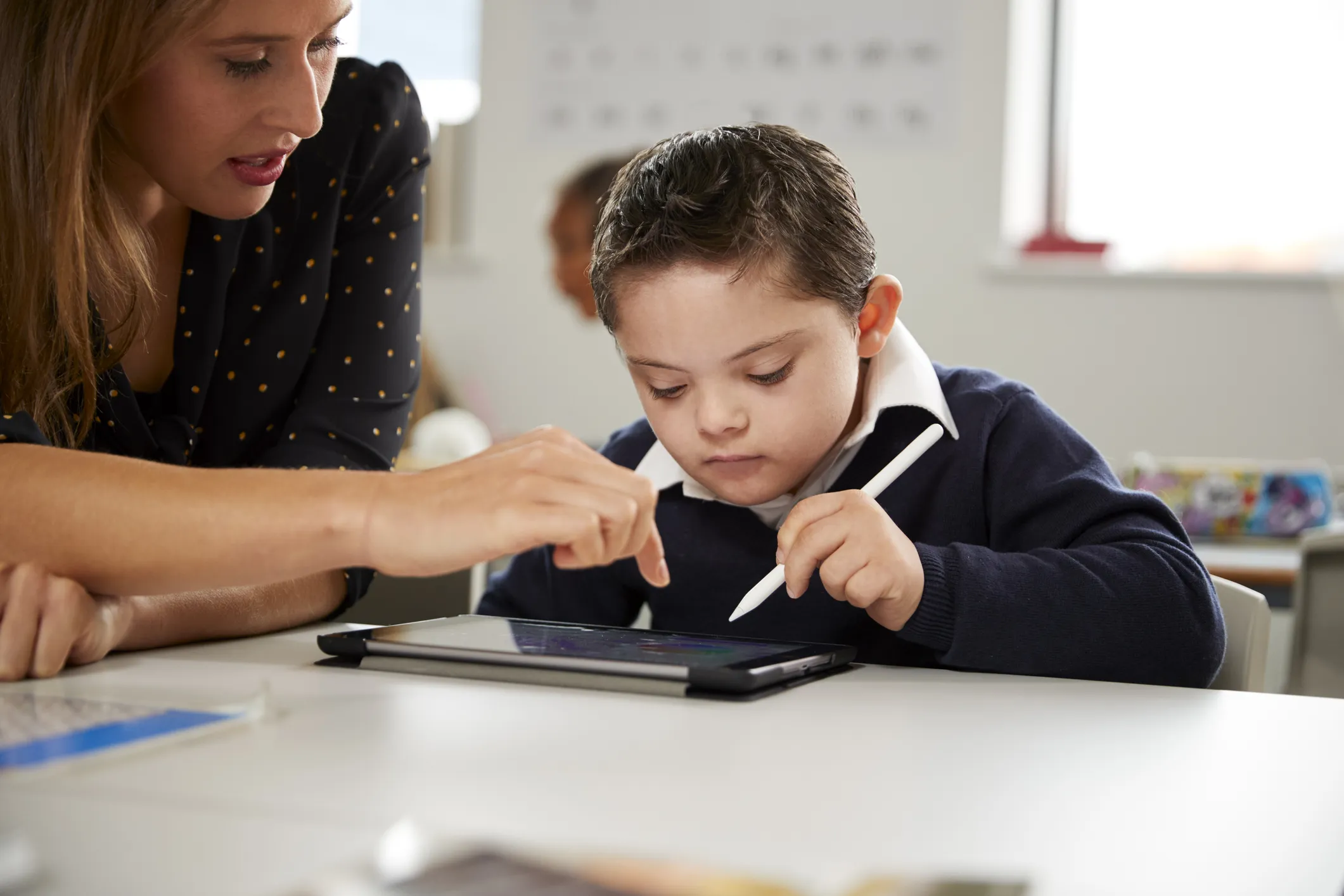February 2, 2024
In a recent blog, we explained how preschool assessment can support great reading outcomes in elementary school. We focused especially on how to help teachers identify children who might benefit from additional support in language and early literacy, and how to systematically evaluate whether preschool programs are “stepping up” to their special opportunity to provide great starts for all learners.
As part of that discussion, we briefly touched on multi-tiered systems of support (MTSS) as ways to leverage assessment data to better serve young students. In this blog, we’ll take a closer look at MTSS in preschool, including its key components, its unique features, and potential solutions to common implementation challenges.
What are the essential components of MTSS in preschool?
Whether the focus is on literacy, math, or social-emotional behavior, the primary goal of an MTSS is the prevention of school problems, similar to how public health efforts seek to prevent illness. As in the elementary and secondary grades, this is accomplished through universal screening, core instruction, interventions, and progress monitoring. The mechanism that links these steps and supports better student outcomes is data-based problem-solving.
Let’s consider each of these components in detail.
#1: Prevention
Reflecting its roots in public health, MTSS provides three levels of prevention services:
- Primary prevention, or efforts to support good outcomes for all individuals, is often described as Tier 1 in MTSS, and includes the core instruction that is provided to all students.
- Secondary prevention, or MTSS Tier 2 instruction, includes targeted or strategic interventions for specific learning needs. Importantly, it is always supplemental to Tier 1 instruction and is usually provided for small groups of students who have similar learning needs.
- Tertiary prevention, or MTSS Tier 3 services, are highly intensive and often individualized interventions provided to students with the most significant specialized needs.
These three tiers of MTSS support offer a preventive and early intervention approach by providing all children with a foundation, along with timely support that builds on that foundation for those who need it.
#2: Universal screening
Early detection of specialized learning needs is key to making this multi-tiered system effective. This early detection is accomplished by regular universal screening, or broad-level assessment of all students.
Universal screeners are typically very brief and focus on key foundational skills known to predict later performance (Cook et al., 2010), and they are often administered each season (fall, winter, and spring). Typically, students’ performance on universal screeners is compared to empirical standards, or “benchmarks,” to identify individuals not making expected progress (Greenwood et al., 2011).
Individual students’ performance relative to these benchmarks provides data to assist teachers in planning Tier 2 or Tier 3 services. Students with scores below a seasonal benchmark are likely candidates for Tier 2 services, while those whose performance is substantially below that benchmark might be considered for Tier 3 services.
#3: Instructional planning for Tiers 2 and 3
The goal of any supplemental or intensive intervention is to help students accelerate learning, such that they can make adequate progress without this additional support. To do this, the content of Tier 2 and Tier 3 services must match the core curriculum, with instructional methods adapted to meet students’ needs:
- For Tier 2 intervention, this often involves intensifying instruction by providing more opportunities for responses, and thus accelerating learning.
- For Tier 3 services, individualized diagnostic assessment and tailored instruction may be more likely.
#4: Progress monitoring
It is important to know if an intervention is working or if adjustments are needed. Students who participate in interventions complete regular progress measures to track their growth (Shinn, 1989). Progress monitoring may be completed every 2–4 weeks at Tier 2, and more frequently (weekly, or even daily) at Tier 3 (VanDerHeyden et al., 2006).
#5: Data-based decision making and the adjustment of instructional services
Progress monitoring data provide the basis for frequent data-based decision making through the evaluation of a student’s progress against a standard of expected growth. Recalling that the goal is to accelerate learning so that a student’s performance is at or above a future seasonal benchmark, this evaluation often compares a graphed “trend line” of student progress to an “aim line” that shows the growth needed to meet some future goal (for instance, an end-of-year benchmark).
When the trend line and aim line track together, teachers know the new intervention is helping accelerate achievement. However, when the trend line falls short of the aim line, a student’s instructional team knows that some change is needed in the supplemental instructional plan (Tilly, 2008).

What makes MTSS in preschool unique—and challenging?
With its common roots in a public health-like approach to early identification and prevention of problems, MTSS in preschool will look familiar to those working with older students. Indeed, implementation of MTSS models in preschool programs has been growing in recent years (Linas & Guerrero, 2016), and several factors may account for this increased interest.
First, states and communities are expanding program and enrollment options, and, increasingly, these programs are aligned with K–12 programs operated by local school districts or other organizations. This growth has coincided with a surge in research, media attention, parent and community advocacy, and legislative leadership focused on efforts to improve persistently poor reading outcomes by emphasizing the Science of Reading and the assessment and instructional practices based on that science.
When taken together, educators, advocates, and policy makers are rapidly turning their attention to ways that improving developmental outcomes for preschool children can also support improved academic outcomes in the elementary and secondary grades. To do this, they realize that differentiating intervention—providing the right services and supports to individual students when they need them—is central to success.
Tools for preschool MTSS
Explore Renaissance solutions designed for preschool learners.
The research foundation for MTSS in preschool
Early educators have a growing array of instructional practices (Diamond et al., 2013) and curricular materials they can use to support preschool instruction. Moreover, early education has been steadily expanding its notion of developmentally appropriate practice to include educational efforts that:
- Fit the needs and preferences of both young children and the adults who serve them; and
- Contribute to important developmental gains in preschool and beyond (Reynolds et al., 2023).
Research and program development over the last few decades have also identified developmental precursors to later academic success (e.g., Walker et al., 1994) and classroom activities and instructional practices that accelerate these developmental gains (Neuman et al., 2021; Neuman & Wright, 2014).
These and other current and emerging features of the early education landscape create strong foundations for MTSS in preschool classrooms, and for the short- and long-term benefits these systems are expected to provide. They are balanced, however, by some possible challenges to adoption or implementation of MTSS in preschool.

Common challenges to implementing MTSS in preschool
Based on our experience, preschool programs are most likely to encounter the following challenges when implementing an MTSS framework.
Challenge 1: Providing more intensive services in Tier 1
The core logic of MTSS is somewhat at odds with the fact that some preschool programs are “targeted,” or expected to enroll children who—for demographic or other reasons—are considered to be at risk for later academic achievement problems. The federal Head Start program is perhaps the most noteworthy targeted preschool initiative, serving:
- Children living in poverty.
- Children from families receiving TANF (Temporary Assistance to Needy Families) or SSI (Supplemental Security Insurance).
- Children in foster care.
Many states and communities have taken similar approaches, often as the initial phase of expanded preschool enrollment. These “targeted” efforts are often recommended for directing scarce resources to children most in need of early intervention and support. Similarly, young children with disabilities often are provided with supports through specialized preschool programming.
These eligibility standards may increase the proportion of children in a classroom whose assessed performance suggests a need for supplemental or intensive intervention.
When most of the children in a classroom have more pressing needs, the simple MTSS logic of differentiated intervention is challenged. In essence, Tier 1 services must be intensive—perhaps more like Tier 2 or Tier 3 services for a more heterogeneous group of children—and thus a very different instructional delivery model may be required.
Challenge 2: Maintaining children’s engagement
While we’ve long heard that child-directed activity and “play-based” learning are essential features of preschool, early educators are increasingly acknowledging the need to provide preschool experiences that are engaging and fun, but also provide the content focus and sequenced approach to learning that is likely to improve outcomes.
In other words, preschools are providing more teacher-directed classroom activities and instruction, as well as an explicit focus on narrower “skills” development, as an essential part of their programming.
In cases when individual children need more intensive levels of preschool experience, it’s incumbent on early educators (and the program and curriculum developers who support them) to make their interventions engaging for students. To do this, early educators need to embrace marrying “engagement” with instructional rigor.
Challenge 3: Selecting rigorous assessment tools
Early education has a still-evolving commitment to objective assessment, and to empirical standards for evaluating the status and progress of individual children. Often, assessment practices in early education rest on teachers’ observations of individual student behavior and the subsequent qualitative evaluation of this behavior using structured developmental checklists.
While sometimes useful in a general sense, this approach to assessment is often lacking in both the specificity and psychometric rigor needed to identify a student’s need for intervention. Issues in the design and use of new assessments in early education somewhat parallel the changes in curriculum and instruction.
While we now want assessment practices in early education that rigorously provide actionable information about individual students and their developmental needs, teachers and students demand that these assessments be engaging, fun, and useful (McConnell & Goldstein, 2021).

How Renaissance supports effective MTSS in preschool
Across the preschool-to-high-school continuum, Renaissance has a deep commitment to MTSS as a way to accelerate learning for all students. This includes a strong—and growing—focus on needed tools for MTSS in early education.
We address this need through:
- Star Preschool Literacy and myIGDIs for Preschool, which provide research-based, engaging, and rigorous assessments for universal screening and progress monitoring in language and early literacy in both English and Spanish, mathematics and early numeracy development, and “whole child” multi-developmental status. All measures have been developed specifically for preschool children, have strong psychometric characteristics, and have empirical standards to produce benchmarks for seasonal screening.
- FastBridge PreK offers additional preschool assessment options through its earlyMath and earlyReading tools. When used for universal screening, preschool children complete 3 or 4 subtests that yield a composite score that can be compared to empirically derived benchmarks. When used for progress monitoring, earlyMath and earlyReading offer a variety of subtests that can be matched to an individual student’s intervention focus. FastBridge also offers devMilestones, a behaviorally anchored rating scale that includes items across six developmental domains.
- Finally, eduCLIMBER is an essential resource for gathering, interpreting, and acting on the seasonal results of Star Preschool, myIGDIs, or FastBridge PreK within an MTSS framework. eduCLIMBER further helps you to drive whole child supports at each tier, monitor key performance indicators to drive greater equity, and more.
To sum up, the promise of MTSS is simple: By aligning the learning experiences of children from preschool to elementary school (and beyond), and by systematically monitoring and supporting individuals’ growth along this journey, we increase the odds that we can provide great experiences that support strong—and lifelong—accomplishment for all children.
References
Cook, C.R., Volpe, R.J., & Livanis, A. (2010). Constructing a roadmap for universal screening research beyond academics. Assessment for Effective Intervention, 35, 197–205.
Diamond, K. E., Justice, L. M., Siegler, R. S., & Snyder, P. A. (2013). Synthesis of IES research on early intervention and early childhood education (NCSER 2013-3001). Retrieved from: http://ies.ed.gov/ncser/pubs/20133001/pdf/20133001.pdf
Greenwood, C. R., Carta, J. J., & McConnell, S. R. (2011). Advances in measurement for universal screening and individual progress monitoring of young children. Journal of Early Intervention, 33(4), 254–267.
Linas, M. W., & Guerrero, G. (2016). The use of Response to Intervention in early childhood. In A. Garro (Ed.), Early childhood assessment in school and clinical child psychology, (pp. 73–93). New York: Springer.
McConnell, S. R., & Goldstein, H. (2021). Measurement built for scale: Designing and using measures of intervention and outcome that facilitate scaling up. In J. A. List, D. L. Suskind, & L. Supplee (Eds.), The scale-up effect in early childhood and public policy (pp. 301–319). New York: Routledge.
Neuman, S. B., & Wright, T. S. (2014). The magic of words: Teaching vocabulary in the early childhood classroom. American Educator, 38(2), 4–13.
Neuman, S. B., Samudra, P., & Danielson, K. (2021). Effectiveness of scaling up a vocabulary intervention for low-income children, pre-K through first grade. The Elementary School Journal, 121(3), 385–409.
Reynolds, A. J., Smerillo, N. E., Ou, S.-R., Loveman-Brown, M., & Varshney, N. (2023). School performance in third grade after a full-day vs part-day preschool program. JAMA, 330(22), 2214–2215.
Shinn, M.R. (1989). Curriculum-based measurement: Assessing special children. New York: Guilford Press.
Tilly, W. D. (2008). The evolution of school psychology to a science-based practice: Problem solving and the three-tiered model. In A. Thomas & J. Grimes (Eds.), Best practices in school psychology V (Vol. 1, pp. 17–36). National Association of School Psychologists.
VanDerHeyden, A.M., Broussard, C., & Cooley, A. (2006). Further development of measures of early math performance for preschoolers. Journal of School Psychology, 44, 533–553.
Walker, D., Greenwood, C. R., Hart, B., & Carta, J. J. (1994). Prediction of school outcome based on early language production and socioeconomic factors. Child Development, 65, 606–621.
Learn more
Connect with an expert to explore Renaissance solutions for preschool MTSS.

